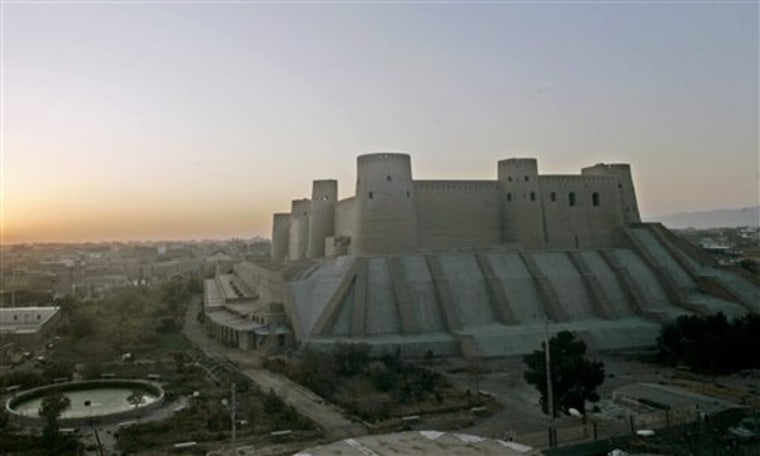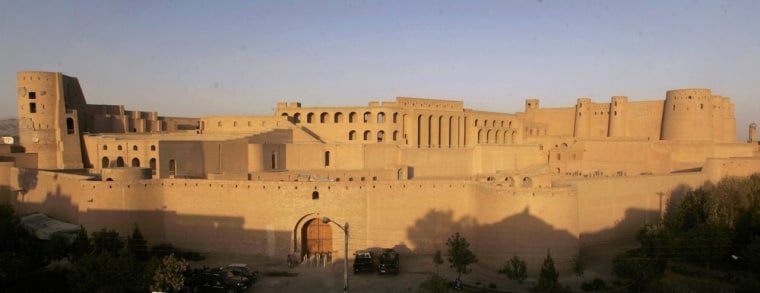In the 1970s, tourists traveled to western Afghanistan to climb on the ruins of an ancient citadel, a fortress resembling a sandcastle that has stood overlooking the city of Herat for thousands of years.
The citadel was crumbling then, but today the newly restored structure, dating back to the days of Alexander the Great, is a hopeful sign of progress in a country beset by war.
Hundreds of Afghan craftsmen worked to restore the ruins' past glory with help from the Aga Khan Trust for Culture and about $2.4 million from the U.S. and German governments.
The U.S. ambassador to Afghanistan, Ryan Crocker, was among the tourists drawn to Herat decades ago, and on Sunday he celebrated the citadel's restoration and the opening of a new museum of Afghan artifacts at the site.
"Until 35 years ago, tourists from around the world came here to experience heritage, history and incomparable national landscapes," Crocker said.
"We look forward to the day when Afghans and visitors from around the world will once again come here to learn about Afghanistan's rich history and enjoy the great hospitality and beauty that this land and its people have to offer," he said.
Tourism seems far-fetched in Afghanistan, where tens of thousands of foreign troops are in their 10th year of fighting Taliban insurgents.
Yet, the rebuilt, imposing brick structure called the Qala Ikhtyaruddin is a new symbol of the nation's desire to emerge from the bloody conflict.
"As this citadel represents, Afghanistan stood as a great nation. It will so stand again," Crocker said.
Taliban attacks have recently occurred inside Herat. They are rare, though there are districts on the city's outskirts where violence flares.
While there was mention of the recent attacks, several officials at the ceremony were warning of another threat: Uncontrolled development that is endangering other historical sites in the city along the famous Silk Road that linked Europe and Asia in ancient times.
"As we sit within the high walls of this impressive monument celebrating the fruits of our joint effort to save this site, I would like to remind all those present here that the rate at which historic quarters and buildings in this city are being destroyed far surpasses the four dozen buildings that we've restored over the past seven years," said Ajmal Maiwandi, chief executive officer of the Aga Khan Trust for Culture.
The Ministry of Information and Culture is now the caretaker of the citadel, which has survived years of territorial battles among Persians, Uzbeks and Afghans and today's Taliban.
The current structure was built on the site of an ancient citadel that some historians claim was established by Macedonian warrior-king Alexander the Great around 330 B.C. The battlements and towers that still stand are believed to date from the 14th or 15th century when it was reconstructed after being destroyed by Mongol invaders. Some of the blue tile work from that period can still be seen on some towers.

UNESCO did extensive renovation at the site in the 1970s. The Culture Ministry took over stewardship at the site in 2005 and has worked since 2008 with the Aga Khan Trust for Culture and the U.S. and German governments to restore the structure and set up a museum at the site. U.S. support for the citadel restoration came from the U.S. Ambassador's Fund for Cultural Preservation and is the fund's largest project in the world.
Mohammad Rafiq, a mason from Herat who worked on the project, said he took pride in the work because he sees it as part of the country's broader reconstruction.
"It was not only about making money. It was good work to do," he said. "This is the biggest monument in the region. We tried our best to do the reconstruction so that it recopied the old styles of the building."
Housed at the citadel is the National Museum of Herat, one of four provincial museums in Afghanistan to reopen to the public. The Museum of Islamic Art in Berlin worked with the German Archaeological Institute to document and restore artifacts and prepare them for display. There are about 1,100 items from the Herat region in the museum; about 250 are on display.
Most of them are from the 10th to 13th centuries when Herat was a center of politics and culture. There is pottery, metal work, a tombstone of major Persian painter Behzad, 260 manuscripts and books and a cenotaph adorned with tiles that date from 1378.
Nancy Dupree, an American who has worked in Afghanistan for decades to protect and preserve the country's culture and heritage, stood outside the museum and glanced up at the citadel's sunbaked towers.
"I've been here many times, but it was crumbling," she said. "This is impressive."
"I think the most exciting thing is to see something finally accomplished. I have seen so many half-finished things."
